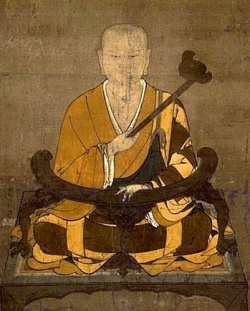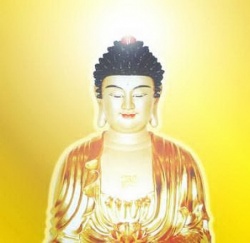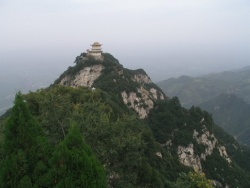Buddhism in China, Japan and Korea By Swami Abhedananda, Sri Ramakrishna Vedanta Math (Belur Math)
In 522 AD Buddhism was introduced in Japan by a Chinese Buddhist, Shiba-Tatsu by name, who lived in Japan as a naturalised Japanese subject. He built a small temple of Buddha at Saktahara in Yamato. But at this time Buddhist doctrines did not become popular among the Japanese. It is well known to the historians that in 65 AD China sent a mission to India to bring some relics of Buddha and some copies of the Buddhist scriptures. The mission returned to China after two years in 67 AD. Within three centuries after this, Buddhism was well established in Korea. The king of Hakusai, in Korea sent a golden image of Buddha and some of the sacred scriptures to the Mikado of Japan in 522 AD. In the following year the Mikado had an image of Buddha carved out of a log of camphor-wood tree that was found ashore near the capital and had it set up in his palace. In 554 AD nine Buddhist monks came from Korea to take the place of the seven who were sent before by the King of Hakusai. They belonged to Jo-Jitsu and Sanron sects, which are now not recognised in Japan.
During the reign of the Mikado Bidatsu Tenno, the king of Hakusai, sent to Japan in 576 AD a number of sacred books and more monks and nuns, the teachers belonging to Ritsu and Zen sects among the Buddhists, together with an exorcising Monk, and architect and an image-maker. In 584 AD two Japanese brought from Korea the images of Shaka (Sakyamuni) and Miroka (Maitreya-Bodhisattwa). The owner of these as well as some of the relics of Buddha’s body named Sogono-Iname, the son of Umako, built the first Pagoda in Japan and had them enshrined.
Within a short time after this there broke out a pestilence, which caused Buddhism to be suppressed for a while. But Umako received special permission from the Mikado to practise privately the sacred rites of this new faith. The next Mikado was cured of his dangerous illness by the Buddhist priests, and for this reason he favoured the spread of Buddhism in Japan.
In the reign of this Mikado great many monks were invited over from Korea to spread the teachings of Buddha. Some of the most celebrated Buddhist temples were built in Japan during this period, such as Tennoji at Ozaka, Udzumasa near the modern Kioto, Asuka-dera, Darumaji, Tayema-dera, Kume-dera, and Tachibanadera in Yamato. Probably (Hinayana) Sho-jo doctrines were preached by three Korean monks.
In 623 AD the Chinese monks came for the first time to Japan. The number of temples and monasteries began to increase steadily. In 625 AD Buddhism was taught publicly in Japan. The Mikado Kotoku Tenno was a staunch follower of Buddhism. During his reign (645-654 AD) a Japanese Monk named Do-sho was sent to China to study under Yuan-chuang (Hiuen Thsang), the great pilgrim who spent many years in India. He is called Gen-jo Sanzo by the Japanese. But Yuan-chuang referred him to the Monk Eman of the Zen sect from whom Do-sho received instruction on the practice of meditation. In 658 AD two other Japanese monks were sent to China to study under this celebrated pilgrim.
The Mikado Temmu Tenno reigned between 673 and 686 AD. He endowed the monasteries with lands and made them independent of all government control. He built the temple Yukushi-ji near Nara and ordered by edicts that every house in Japan should have a Buddhist shrine and some sacred scriptures of Buddhism. Cremation was first practised in Japan in 700 AD. In 710 AD was built at Nara the great monastery of Kobuku-ji.
The Mikado Sho-mu Tenno decreed in 737 AD, after an epidemic of small-pox which almost depopulated the country, that a large monastery should be established in each province. The seven-storied pagodas each were also built by him in each province. He further gave the order to copy more of the Buddhist scriptures. It was he who founded the great temple at Nara which holds the colossal statue of Dai-nichi Nio-rai.
In 737 AD an Indian Monk named Baramon (Brahmin) Sojo visited Japan landing at the port of Ozaka where he was met by the celebrated priest Gio-gi Bosatsu (Bidhisattwa). This title was conferred on the priest (Gio-gi) by Sho-mu Tenno. Later on, this title of Bosatsu was abused by the noble men of Japan, and that abuse was stopped by the edict of the Mikado Iyeyasu in the beginning of the 17th Century.
In 754 AD a Chinese Monk named Chieu-Chen (Kan-shin in Japanese) visited Japan and introduced the doctrines of Ritsu sect. It was through his influence the Mikado Sho-mu Tenno renounced his throne and joined the monastic order. His daughter Ko-Ken Tenno became a nun. Following the example of the Mikado four hundred persons of high rank renounced the world and became monks. His example was also followed by other ruling Mikados who succeeded him.
In 767 AD the temple at Nikko was founded by the Monk Sho-do. In 805 AD the doctrines of the Tendai sect were introduced from China by the Monk Den-gio Dai-shi, the first Abbot of Hei-Yei-Zan. In 806 AD Kobo Dai-shi returned from China and promulgated the teachings of Yogachara school and founded the sect called Shin-gon. His teacher was the Chinese Kei-Kwa (Hui-Kuo). Three centuries later Rio-nin founded the sect Yu-dzu Nembutsu. In the end of the 12th century the Jo-do sect was established by Ho-nen Sho-nin. There are many sub-sects of the eight principal sects among the Buddhists of Japan. The following table shows these eight with the number of temples or monasteries belonging to each:
| Temples and monasteries | |
|---|---|
| Tendai (3 sub-sections) | 5088 |
| Shin-gou (2 sub-sections) | 13,358 |
| Jo-do (3 sub-sections) | 8,478 |
| Rinzai (9 sub-sections) | 7,081 |
| Zen So-to (9 sub-sections) | 14,021 |
| O-baku Shin (10 sub-sections) | 18,783 |
| Nichi-ren (7 sub-sections) | 5,085 |
| Ji | 501 |
| Yu-dzu Nem-butsu | 347 |
The three sub-sects of Teu-dai Shiu are:
- Euriaku-ji. The principal deity of this sub-sect is Yakushi Nio-rai (Bhaishajyaguru) with whom are associated two Bodhisattvas (Bo-Satsu) Nikko and Gwakko; Bouten (Brahma); Tai-Shaku (Indra) the Shi-Tenno (four kings of the Devas or gods); and the Jiu-ni-Jin-sho (twelve divine leaders). All of these are placed on the altar.
- The Midera sub-sect worship Mi-roku Bo-satu (Maitreya Bodhisattva).
- The Shin-Sei sub-sect worship Amida Nio-rai (Amitabha Tathagata) as their principal deity.
The Ten-dai sect is named after the mountain Tientai Shan in China, where the founder of this sect Chi-sha Dai-shi. A Chinese Monk first taught his doctrines.
The sacred book of this sect is Ho-ke-kio (Saddharma-Prajnaparamita-Sutra-Sastra) called Chi-ron and supplemented by Ne-han-gio (Mahaparinirvana-Sutra). In the Chi-ron is given the law of meditation by which the aspirant is enabled to recognise The Buddha under all forms he has assumed in order to save mankind. According to this sect the principal means for attaining spiritual insight is meditation and the practice of asceticism (Kwam-mon) which is confined to monks.
The central doctrine of this sect is that Nirvana means the ultimate result of existence. It is a state in which the individual remains unaffected by anything external, and consequently, is devoid of feeling, thought or passion. This absolute unconditioned existence is called Mu-I (Asamskrita). It is the annihilation of conditions and not of the substance of the individual. To the uninitiated it will be regarded as the absolute non-existence.
This sect reverences Shaka (Sakyamuni), Monju (Manjusri), Fugen (Samantabhadra), Fu-do (Achala), Kwan-non (Avalokiteswara) under his different forms such as the eleven faced, the horse headed, the thousand-handed, the Holy, Dainichi (Vairochana), Ashuku (Akshobhya), Ho-sho (Ratnasambhava). The Ten-dai sect formerly worshipped numerous Shinto gods, such as Sanno, Tenjin Sama, Inari, Shimmei, Otori, Hachiman and Godzu Tenno. These were explained as the Avataras (incarnations) of the Buddhist deities. For instance, Inari was Kwan-non (Avalokiteswara).
After the revolution of 1868 AD Buddhism in Japan was separated from Shintoism, which from that year was made the state religion of Japan. Shin-gon-shiu sect derives its name from the Chinese word for Mantra in Sanskrit. It is identical with Yogachara school which was founded by Riu-ju (Nagarjuna) or Riu-mio. He is said also to have taught the doctrine of Dai-nichi (Vairochana). The doctrines of this sect are based on the three Sutras: the Dai-nichi Kio (Mahavairochana-bisambodhi-Sutra), the So-shit-Chi-kio (Susiddhi-karama-Mahatantra-sadhanopasika-Patra) and the Kon-go (Vajrachakra-Sutra). This sect observes mystic rites with signs (mudra), Shin-mitsu, go-mitsu (dharana) and I-mitsu (Dhyana). This and Ten-dai sect teach the practice of fasting for purification. Vairochana was the founder of this school. He transmitted the doctrines to Kon-go (Vajrasattva) who was succeeded by Riu-mio (Nagarjuna). Kobo-Dai shi introduced this sect into Japan.
According to the teaching of this sect every human being possesses within himself the six elements of the spiritual body (Dharmakaya) but is unconscious of them until Dai-nichi enters into his heart and enables him to recognise the truth. Through the practice of the above mentioned mystic rites under the guidance of Ajari one may gain perfect knowledge. The deities of this sect are within the soul. They are states of the mind. Dai-Nichi (Vairochana) is explained to be the sum total of all Sentient beings.
Zen Shiu is the contemplative school in China. It was founded by the Indian Dharma who came to China in 527 AD and died there about eight years later. He was the first of the Chinese Patriarchs. The principal teachings of this sect are that truth cannot be expressed by the words of the mouth, that it is only by introspection that the meaning of Buddha can be learnt. It is unnecessary to worship him or to study the sacred scriptures, still it allows the study of Dai-hannia-Kio simply as a means of educating the intellect. Its creed is: "Look within and there you will find The Buddha". In most of the temples of this sect Shaka (Shakya) is placed upon the altar between Kasho (Kashlyapa) and Anan (Ananda). The Trinity of this sect is Shaka, Miroku (Maitreya) and Amida (Amitabha). In Japan this sect has two branches Rin-zai and So-to named after two Chinese monks of the 9th century. The Ohaku sub-sect was founded in Japan by In-gen, the Chinese Monk.
Jo-do Shin sect was founded by the Indian Monk Me-mio (Asvaghosha). It was introduced in China by Bodairushi (Bodhiruchi) who translated Vasubandhu's Shastra and other Upadesha into Chinese. The Tendai sect teaches that the study of the whole canon and the practice of asceticism and meditation are the means of attaining salvation. But this sect believes in the teaching of Riu-ju (Nagarjuna) who taught that it is impossible to attain salvation by individual efforts in this age of the decay of religion, and substituted for this difficult path to Nirvana the simple faith in the all-saving Power of Amida (Amitabha). This relying upon the strength of another is called Ta-riki. Their Mantra is "Ta-riki chin no ji-riki" (self-effort depending on the effort of another). Jo-do means (Sukhavati) where all mankind will eventually go before attaining to perfect Buddhaship.
In the temple of this sect Amida is chiefly worshipped. Sometimes the Shinto deities Inar and Benteu are worshipped. Chion-In at Kioto and Zo-jo-ji at Tokio are the principal seats of the two chief divisions of this sect. Nichi-reu-shiu is purely a Japanese sect. The principal belief of this sect is that all living creatures, plants and even this earth will eventually attain to Buddhahood. But man must work out his own salvation by practising according to the teachings of Buddha and by constant prayer and not by the grace of Amitabha as taught by Jo-do and Shin sects. There are two forms of teachings of this sect; the one symbolic for the lay people, the other the pure truth for the advanced students. This sect worships Shakya and believes that 3000 years after the year of the birth of Shakya there will come Miroku (Maitreya) who will convert all those who have not yet attained to Buddhahood. The lotus is the emblem of Shaka. Niche-reu was the founder of this sect.
Shin-shin sect has much similarity with the Jo-do sect in their worship of Amida (Amitabha) and in the use of the Sukhavativyuha-Sutra (smaller) as the basis of its doctrine. It differs from the Jo-do sect on the most important point of the doctrine. Jo-do teaches that salvation can be gained by simply repeating the invocation to Amida, while this sect teaches that salvation is to be attained by faith in the Power and willingness of Amida to save mankind, and that the invocation is to be used like an act of thanks-giving. Through faith alone one is taken after death under Amida’s protection. While Jo-do sect believes Amida will come to meet the soul after death and take it to paradise.
This sect is called the Protestantism of Japan, as the priests are allowed to marry. It is popularly known in Japan as the sect of Nishi Hon-gwani at Kioto. This sect has the richest temples and does the missionary work in China and Korea and maintain a high standard of education among the neophytes. This sect believes that salvation or Nirvana means happiness and is the state of Buddha. It teaches the doctrine of "Help from Amida".



